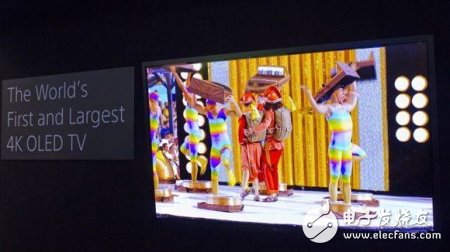From the current form, the development of OLED TV is still a "bottomless hole" that requires a lot of capital investment, so we were not surprised when Sony recently announced that it would give up the news of OLED TV research and development.
This decision has great commercial significance for Sony, because after a huge loss in successive years, Sony has now had a very good improvement in LCD TV and 4K TV. Generally speaking, consumers want to see a product with top quality, but at a price, but there seems to be no progress for OLED technology. As a veteran TV manufacturer, Sony is also the only Japanese company in the OLED field to compete with South Korea's Samsung and LG.
At the beginning, Sony decided to develop the philosophy of OLED TV, which temporarily bypassed the research and development of curved OLED, high-definition OLED and other products, thereby directly increasing efforts to develop 4K ultra-high-definition OLED TV products. If LG's 1080p HD OLED TV is still performing well, then we can't help but ask what the future of 4K Ultra HD OLED TV will look like.

A few years ago, Sony and Panasonic have been working together to develop a new production process for 4K OLED panels, and it seems to have made good progress. With the new technology, special organic materials are used as the luminescent layer. It is said that the manufacture of 4K OLED panels through new technologies is more cost-effective than it is now.
At that time, the two Japanese giants saw a bright future, eagerly looking forward to the successful launch of 4K ultra-HD OLED TVs, and have already pushed the products to the market. At the 2013 CES Consumer Electronics Show, Sony and Panasonic jointly launched the world's first 4K OLED TV, which is exciting for the world.
However, from the actual market performance of the products, it did not achieve the expected results, and Sony and Panasonic also terminated the partnership in December. Although we still hope that the two companies can continue to develop related products from then on, but after Sony has begun to purchase OLED panels directly from other manufacturers and give up their own research and development, this affordable 4K OLED TV has become a A fragmented dream.
In fact, 4K OLED TV is not the first time Sony has made the world a stunning display product. Remember Sony's next-generation self-luminous display technology "Crystal LED Display" at CES 2012? At the time we were equally surprised by it. Crystal LED Display is a self-illuminating display technology that combines Sony's unique way. By placing ultra-fine LED light-emitting diodes on each RGB pixel, the added RGB LED light source directly acts on the surface of the display layer, thus significantly improving the use of backlight. effectiveness. The picture displayed in this way can display higher contrast in the light and dark environment, has a wider color gamut and faster response speed of the video picture, and can be realized more widely than the existing LCD liquid crystal and plasma display methods. Perspective and lower energy consumption.
But only so, until now, there is no more.
Of course, the display industry has been performing the ideal crack and the demise of technology, and the most famous non-plasma technology is. There are even tragedies like the SED that have not yet come out of the product. Therefore, while technology companies are leading the development of technology, it is easy to bring it into a dead end.
This time, Sony's OLED dream has been broken, and I don't know how long Samsung and LG still stick to this road can persist. I don't know how much money they have to invest.
Ei 76 Transformer,76V Transformer,Ei-76 Transformer,Audio Output Transformer,low voltage lighting transformer
Guang Er Zhong(Zhaoqing)Electronics Co., Ltd , https://www.poweradapter.com.cn
